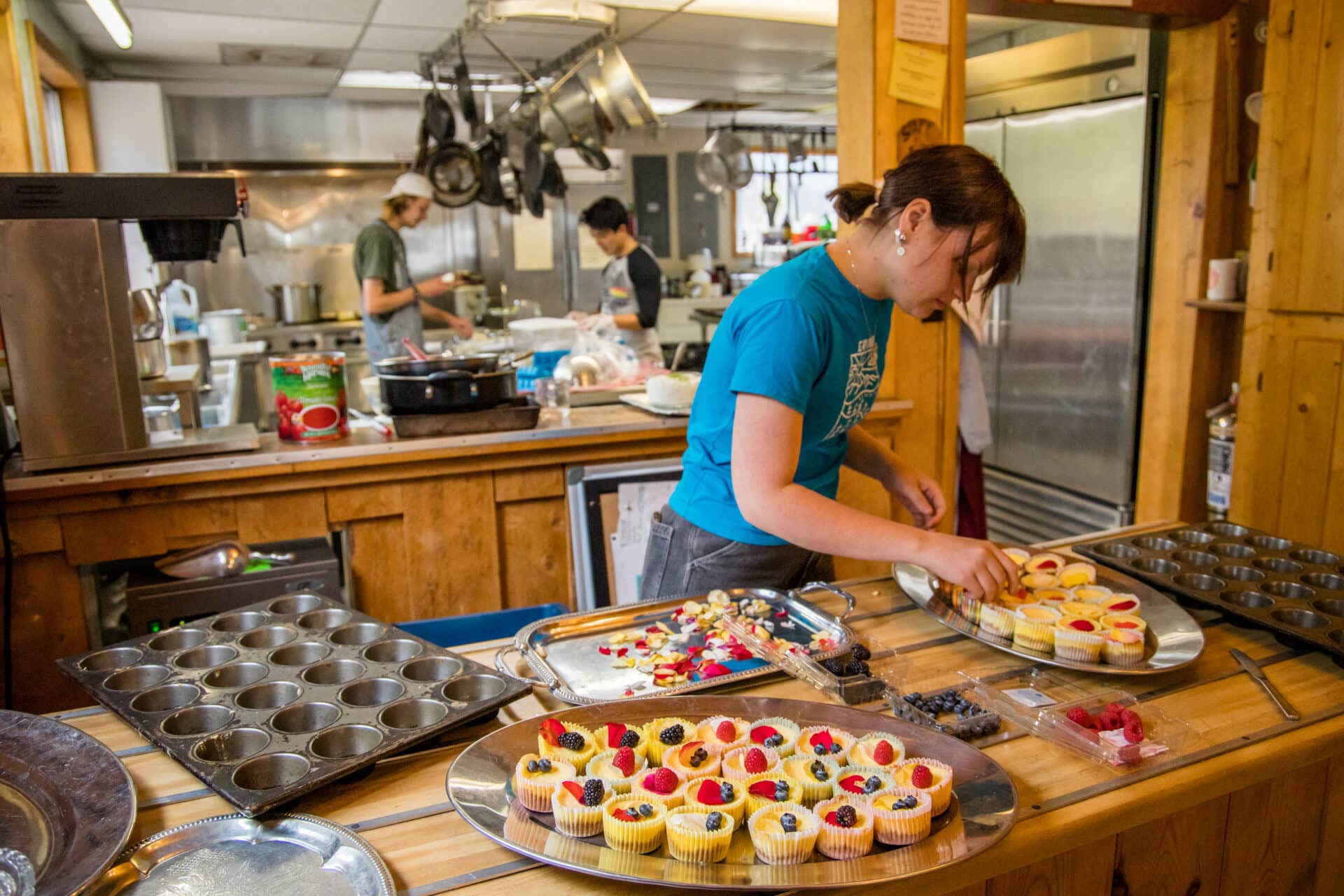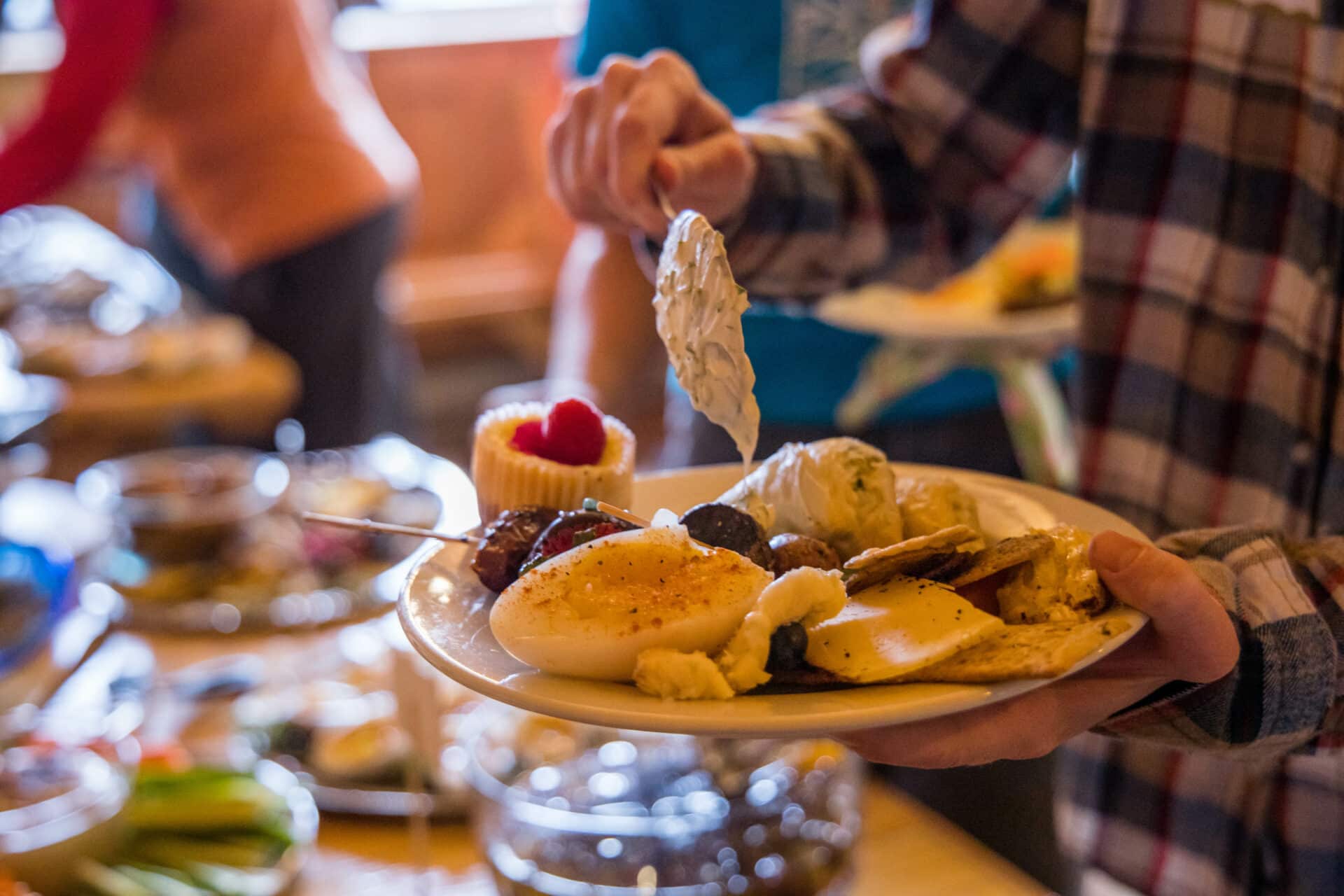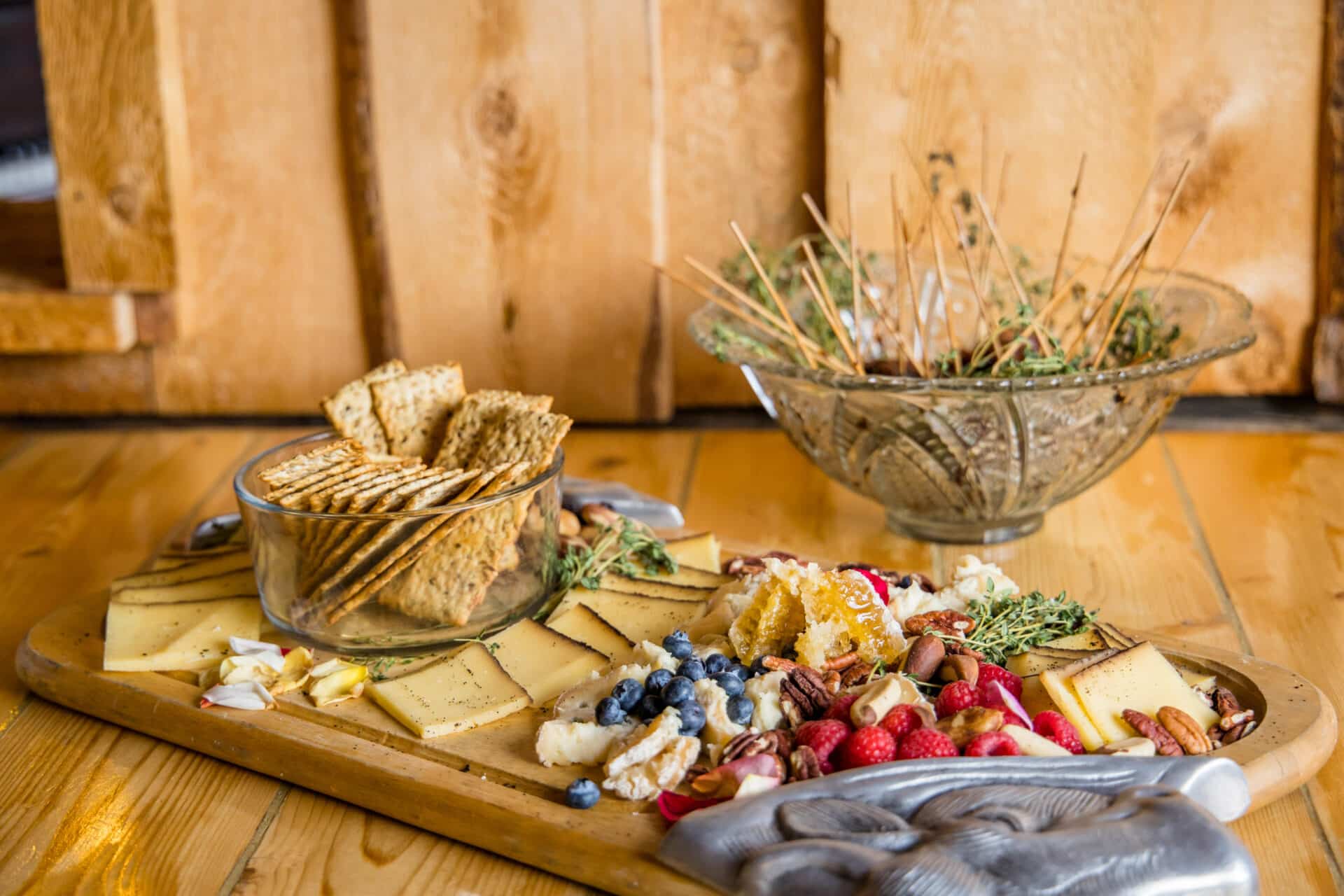Compassionate Kitchen
Good food, company, and community.
Our Compassionate Kitchen is not a restaurant, but a part of the group experience. This means we only prepare meals for groups who have arranged to eat with us. Guests who are not part of such a group may be able to purchase meals when groups are present, and are also welcome to prepare food in our guest kitchens (there's one in both Rempel Lodge and Cliffside Lodge, and the Upper Fireside and Riverbend cabins have their own full kitchens). A place where the food we prepare and serve is an extension of our mission, our kitchen is full of delicious, nourishing food, camaraderie, and freshness. It’s also got the best view in town! We serve tasty and nutritious meals with care and attention. This is one more way to bring our daily decisions into alignment with a restorative world. From planning menus to buying, preparing, and serving, our goal is to live both well and lightly on the earth.
Our Focus
Our Compassionate Kitchen works to source seasonal, local, and organic (SLO) ingredients when possible. By taking this SLO approach to food (not be confused with, but in support of, the Slow Food movement), our Cook is able to deepen the connection between our food and our mission.
Most other cultures of the world use meat as a side dish or accompaniment rather that as the main course. Great soups and stews with no meat or small amounts of meat can also include the freshest vegetables and fruits of the season. We can make a non-meat main entrée unforgettable with bold flavors and wonderful aromas, and let meat take a back seat some of the time.
Our Compassionate Kitchen is not about choosing a totally vegetarian menu, but about focusing more on the beautiful, seasonal vegetables of the Colorado bounty. While we do not serve meat at every meal, when we do serve it we do our best to source local and/or organic meat and poultry.
Beans and grains are also great protein sources. When we serve vegetarian dishes, we are careful not to simply replace meat with tofu, seitan, or something highly processed like textured vegetable protein (TVP). We aim for using whole foods that bring immense flavor and high nutritional value all on their own. Golden Organics in Denver often supplies us with beans, grains, and other staples.
Fresh seasonal fruits and vegetables from local or regional sources are a tasty and nutritious part of each meal served at Shadowcliff. Over the years we have sourced as locally as possible for fruit and veggies. As local farms go through their own transitions, we continue to connect with the abundance of farms in Colorado, cultivating new partnerships where possible.
Sometimes we do have to choose conventionally grown fruits and vegetables. In this case, we try to stick to those with the least pesticide residues: asparagus, avocados, bananas, broccoli, cauliflower, sweet corn, kiwis, mangoes, onions, papayas, pineapples, and sweet peas. As an aside, in your own kitchen it’s advisable to avoid these twelve soft-skinned fruits unless you can get them organic or pesticide-free: strawberries, spinach, kale, nectarines, apples, grapes, peaches, cherries, pears, tomatoes, celery, potatoes. You can learn more here.
Shadowcliff guests have come to expect delicious, high-quality meals at our table. Our job is to know the price of each ingredient served in terms of not just dollars but also ecological and social justice. We can be economical without sacrificing quality, serve satisfying quantities while minimizing waste, and respond to special dietary needs (gluten-free, dairy-free, vegetarian) when reasonably possible.

Preparation
Have you read the book Like Water for Chocolate? It might just make you a believer in the power of one’s thoughts and feelings in the kitchen. This is something we subscribe to by encouraging our staff to come into the kitchen with a happy heart, appreciate their co-workers, consider how they can be glad to be cooking in this place, and are willing and eager to serve guests and each other.
The Cook can make the kitchen a place for delight and fun, and on occasion, a classroom. The cooks that have passed through our kitchen over the years have taken delight in providing education in skills and nutrition to the staff and guests alike. Many of them have also been gracious students themselves, learning from their fellow staff members and interested guests.
Above all we strive to have a sense of gratitude for the foods that come into this kitchen—a thankfulness that also includes the growers and raisers of the foods and each individual item that nourishes our bodies, our minds and our spirits. Treating our bodies well shows respect and gratitude for the gifts of life.

Serving
One of the greatest impacts of our compassionate kitchen comes in the serving of the meal. At Shadowcliff, we provide a served buffet dining experience where hot items are served to you and cold items are self-serve in the buffet line. Don't let the idea of a buffet fool you!
Eye appeal is the first place to “wow” diners with the beauty and wonderful colors, shapes, and textures of our meals. Taste comes next, but that visual statement will open the door to the other joys of a lovingly prepared and served meal. A friendly staff person willing to answer questions about the menu items on the buffet goes a long way in making guests feel welcome.
Of course, hot foods must be served hot and cold foods served cold, both to maximize the flavors of the food and for food safety. Portion control by a friendly server placing foods on the guest’s plate is a way to minimize waste. Guests are welcome to return for more but begin with reasonable rather than huge servings on their plates.

Clean-up and Seva
Shadowcliff guests who are part of an organized group are asked to help with post-meal seva, a sanskrit word meaning selfless service. Post-meal seva consists of gathering and clearing plates and dishes, bringing them back to the sink, and working with Shadowcliff staff to wash per health code regulations. Cooperative ventures like this are just one more place where we model and share our values every day.
In non-human systems, there is no waste. That is to say, the very idea of waste is a human concept. Composting food waste to provide a garden supplement is an excellent and creative use of waste food products, but Shadowcliff has a difficult situation in this regard. We are a seasonal operation and we have bears. Bears love food scraps. Encouraging their presence on our grounds is no favor to either bears or humans. We continue to research sources for a bear-proof composter but have not yet found the appropriate product. Until that time, we put food waste down our disposal or in the trash dumpster. Helping our guests to be more aware of their own part in minimizing waste is one of our goals.
Thoughts on Purchasing
We use the following four levels of hierarchy principles to guide food purchasing decisions. Maybe give them a try in your own home:
First choice is SLO. Look within a 200 mile radius for seasonal products grown organically to increase flavor and nutritional value, and minimize the air pollution, greenhouse gas production, and fossil fuel use of cross-country trucking systems. Check with farmers’ markets and CSAs (Community Supported Agriculture) within this circle which may supply our needs. Directories, both on-line and in print, like Local Harvest, are also wonderful resources.
Second choice is local conventional and/or some organic. Buying direct from local farmers, especially those using growing methods with careful use of pesticides and chemical fertilizers, are a better choice because less fuel is used to get products to us. The average food item on the U.S. table travels at least 1500 miles before it gets to the plate! Such long distance travel takes time, which in turn means that preservation and, perhaps, an unnatural ripening agent to increase the food’s shelf life, are used. And when it comes to pleasing our guests, fresh food tastes so much better than “old” food.
Third choice is organic that is not local. If other factors are equal, choose organic over conventionally grown or raised foods. The energy costs in producing chemical fertilizers and pesticides are huge. And foods free of residues from these chemicals will surely be safer and taste better.
The fourth choice is conventionally grown food that is produced ethically. Look for trade food items produced by companies concerned with worker welfare and compensation. Search out ethically raised meats, fish, poultry and dairy products. At this writing coffee, tea, chocolate, and rice may be found from fair trade sources. We continually search for sources of ethically raised meats, poultry, and dairy products.
One last important secret to help with food purchases deals with the PLU (product look-up) codes that appear on produce stickers. These will tell you whether the fruit or vegetable is organic, conventional, or genetically modified. PLU codes that begin with numbers 3 or 4 and are four digits long are conventionally grown. Organically grown produce bears the same four digits plus the number 9 at the beginning for a total of five digits. Genetically modified fruits and vegetables bear five-digit PLU codes beginning with the numeral 8. For example, conventional bananas would be code 4011, organic bananas would be code 94011, and genetically modified bananas would be 84011.
Resources of Interest:
- Charlie Casci, ”The Compassionate Kitchen,”Common Ground Magazine, November 2006
- Jay Weinstein, The Ethical Gourmet, Broadway Books, 2006
- The Environmental Working Group, The Ethical Gourmet
- Weinstein, The Ethical Gourmet
- Starhawk, The Earth Path, HarperSanFrancisco, 2004
- The Omnivore's Dilemma: A Natural History of Four Meals, Michael Pollan, Penguin Books, 2006